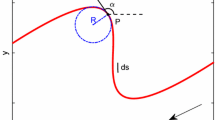Abstract
The curved movements produced by living organisms follow a power law where the velocity of movement is a power function of the degree of curvature through which the movement is made. The exponent of the power function is close to either 1/3 or 2/3 depending on how velocity and curvature are measured. This power law is thought to reflect biological and/or kinematic constraints on how organisms produce movements. The present paper shows that the power law is actually a statistical artifact that results from mistaking a correlational for a causal relationship between variables. The power law implies that curvature influences the velocity of movement. In fact, the power law is a mathematical consequence of the way that these variables are calculated. The appearance that curvature affects the velocity of movement is shown to be an example of a “behavioral illusion” that results from ignoring the purpose of behavior.


Similar content being viewed by others
Notes
While this is not a literal model of how the brain implements these control systems (it would surely require a hierarchy of such systems, for example), it is a useful description of the mechanism of control at the “computational level” (Marr 2010).
References
Catavitello G, Ivanenko YP, Lacquaniti F, Viviani P (2016) Drawing ellipses in water: evidence for dynamic constraints in the relation between velocity and path curvature. Exp Br Res 234(6): 1649–1657. doi:10.1007/s00221-016-4569-9
de’Sperati C, Viviani P (1997) The relationship between curvature and velocity in two-dimensional smooth pursuit eye movements. J Neurosci 17:3932–3945
Gribble PL, Ostry DJ (1996) Origins of the power law relation between movement velocity and curvature: modeling the effects of muscle mechanics and limb dynamics. J Neurophysiol 76(5):2853–2860
Hicheur H, Vieilledent MJE, Richardson T, Flash A, Berthoz (2005) Velocity and curvature in human locomotion along complex curved paths: a comparison with hand movements. Exp Br Res 162: 145–154. doi:10.1007/s00221-004-2122-8.
Huh D, Sejnowski T (2015) Spectrum of power laws for curved hand movements. P Natl Acad Sci USA 112(29):E3950–E3958. doi:10.1073/pnas.1510208112
Ivanenko YP, Grasso R, Macellari V, Lacquaniti F (2002) Two-thirds power law in human locomotion: role of ground contact forces. Neuroreport 13:1171–1174
Karklinsky M, Flash T (2015) Timing of continuous motor imagery: the two-thirds power law originates in trajectory planning. J Neurophysiol 113(7):2490–2499. doi:10.1152/jn.00421.2014
Lacquaniti F, Terzuolo C, Viviani P (1983) The law relating the kinematic and figural aspects of drawing movements. Acta Psychol 54(1):115–130
Marken, R. S. (1980) The Cause of Control Movements in a Tracking Task. Percept Motor Skills 51:755–758.
Marken RS (1988) The nature of behavior: Control as fact and theory. Behav Sci 33:196–206
Marken RS (2001) Controlled Variables: Psychology as the Center Fielder Views It. Am J Psychol 114:259–281
Marken RS (2002) Looking at behavior through control theory glasses. Rev Gener Psychol 6:260–270
Marken RS (2005) Optical Trajectories and the Informational Basis of Fly Ball Catching. J Exp Psychol Human Percept Perform 31:630–634
Marken RS (2014) Doing research on purpose: a control theory approach to experimental psychology. New View, St. Louis
Marken RS, Horth B (2011) When causality does not imply correlation: more spadework at the foundations of scientific psychology. Psychol Rep 108:1–12
Marr D (2010) Vision: a computational investigation into the human representation and processing of visual information. MIT Press, Cambridge
Perrier P, Fuchs S (2008) Speed-curvature relations in speech production challenge the 1/3 power law. J Neurophysiol 100(3):1171–1183. doi:10.1152/jn.01116.2007
Plamondon R, Guerfali W (1998) The 2/3 power law: when and why? Acta Psychol 100:85–96
Powers WT (1973a) Feedback: Beyond behaviorism. Science 179:351–356
Powers, W. T. (1973b) Behaviorism and feedback control, Science 181: 1114,1116,1118–1120.
Powers WT (1978) Quantitative analysis of purposive systems: Some spadework at the foundations of scientific psychology. Psychol Rev 85:417–435
Schaal S, Sternad D (2001) Origins and violations of the 2/3 power law in rhythmic three-dimensional arm movements. Exp Br Res 136:60–72. doi:10.1007/s002210000505.
Schwartz AB (1994) Direct cortical representation of drawing. Science 265(5171):540–542
Shaffer DM, Marken RS, Dolgov I, Maynor AB (2013) Chasin’ choppers: using unpredictable trajectories to test theories of object interception. Atten Percept Psychol 75: 1496–1506. doi:10.3758/s13414-013-0500-7.
Viviani P, Terzuolo C (1982) Trajectory determines movement dynamics. Neuroscience 7:431–437
Wann J, Nimmo-Smith I, Wing AM (1988) Relation between velocity and curvature in movement: Equivalence and divergence between a power law and a minimum-jerk model. J Exp Psychol Human 14(4):622
Willett ABS, Marken RS, Parker MG, Mansell W (2017) Control Blindness: Why People Can Make Incorrect Inferences about the Intentions of Others. Atten Percept Perform. doi:10.3758/s13414-016-1268-3
Wooldridge, Jeffrey M. (2009) Omitted variable bias: the simple case. Introductory econometrics: a modern approach. Cengage Learning, Mason, pp 89–93
Zago M, Lacquaniti F, Gomez-Marin A (2016) The speed–curvature power-law in Drosophila larval locomotion. Biol Lett 12:20160597. doi:10.1098/rsbl.2016.0597
Author information
Authors and Affiliations
Corresponding author
Rights and permissions
About this article
Cite this article
Marken, R.S., Shaffer, D.M. The power law of movement: an example of a behavioral illusion. Exp Brain Res 235, 1835–1842 (2017). https://doi.org/10.1007/s00221-017-4939-y
Received:
Accepted:
Published:
Issue Date:
DOI: https://doi.org/10.1007/s00221-017-4939-y




